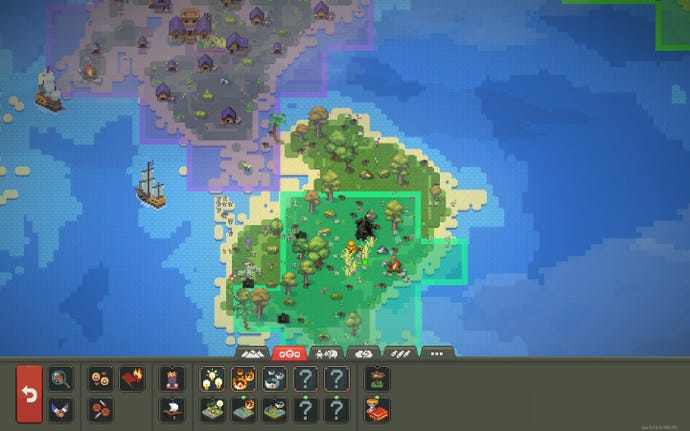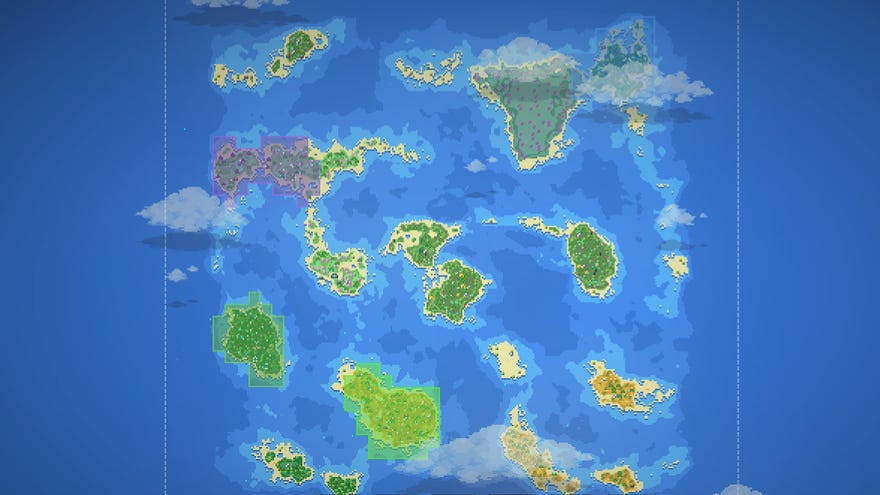In WorldBox, I am a terrible scientist studying the collapse of fantastical nations
Don't make me turn this world around!
I briefly posted before the new year about WorldBox - God Simulator, and Graham wrote about it over the weekend, too. It is a world simulation game that has no resource costs or goals, just simulated events. You make a world, plop some animals and fantasy races into it (and if you want, a bunch of dragons and wizards) and see what happens. I cannot stop playing it. And I wanted to give some more detailed examples of how the simulation works, especially if you just leave it running with little intervention.
I am a WorldBox scientist, you see (though merely a BSc at the moment), and my first experiments suggest that every civilisation, along a long enough time scale, is basically doomed. Big 2022 energy. In the case of WorldBox, this may be because at some stage the scientist running the experiment will get bored and drop in e.g. a tornado. That's okay, because there are almost infinite experiments to run. I hope that isn't how the simulation I am living in is being run. Oh no. Don't think about it.
WorldBox is still in early access on Steam, but already you don't need to put much in to get cool results out. For example, in one of the first worlds I tried, I used the starter world set: a bunch of land masses put together to look like a dragon. So I plopped down a load of orcs on the main continent (the body), put a few dwarves in the tail, and waited to see what would happen. I also put two humans on one of the tiny islands that made up the wings, and forgot about them.
After several centuries, there were some curious results.
The first was that, after they exterminated the dwarves, the orcs expanded too quickly. While their main cities were prosperous, these had used up almost all of the resources on the island. Even after hundreds of years there were vast swathes of their kingdoms where people lived in tents, the lowest tier of housing in the game. They also killed all the buffalo, apart from a small group of the big shaggy beasts that had managed to hide behind a mountain range.

The second was that the two humans I had put on an archipelago maintained sustainable growth due to the extreme confines of their small island. So the next time I properly looked at them, they had occupied all the free islands nearby and carried on prospering, not giving a shit about the rest of the world. They found an island inhabited by giant pumpkin monsters, killed said monsters, and then spent sixty years terraforming that island so they could found a new town there. Not bad for a society that is, presumably, as monstrously inbred as a pre-made cheese and mayo sandwich filling.

The third and most tragic thing that happened was that one tiny dwarf settlement of 13 souls survived the orcs, by being hidden around the bend of the dragon-island's tail, and remaining too small to care about. I felt very sorry for them, so tried to bolster them with resources dropped from the sky, but their population would not grow. This turned out to be because they were all in their 80s. A hidden village of 13 traumatised OAPs, probably living out their final days in abject terror that one day an orc would notice them. This discovery made me too sad, so I left that world to do more experimentation.
My most recent experiment is with the biomes. WorldBox has a bunch of different ones to play around with. There are savannah grasses, jungles, swamps, and even a magic biome where the grass sparkles and trees are pink. So I built a world with a bunch of islands that had different biomes, gave them all equal resources, and then put in two groups of elves and two groups of humans. I want to see what measurable effect different types of land might have.
It's early days (by which I mean: I've been running this world for about an hour) and a group of elves from the savannah and a group of humans from magic-land have progressed far enough to build boats and weapons. They met peacefully in the middle of one island, but then at almost the exact moment the old diplomatic human king died and was replaced by his militarist son, the elf kingdom had a schism and split in two. The elves have started a war with both the humans and each other...

Meanwhile, the biome that appears to have a big impact is the swamp. The unlucky humans I set up next to it have made a weird pincer around the swamp, rather than becoming one with it as I had hoped. Their civilisation has been stunted a little because they recently went into a fit of existential despair at contemplating how they might live in a simulation - I swear I did not make that bit up - and started tearing their own houses down. Also, I filled the swamp with frogs, but now the frogs have all gone. I do not know what happened to the frogs.

And this is just me being vaguely sensible. I am thinking of doing my WorldBox post-grad in animal studies. As in: what if the swamp was full of crocodiles? What does the button marked 'Crabzilla' actaully do? How many bears is too many bears? Honestly, give WorldBox a go.


